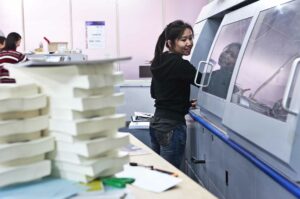Pur binding is a variation of Perfect Book Binding. It uses PUR glue instead of the more commonly used EVA hot melt.
 PUR (polyurethane reactive) bonds differently with paper than EVA (ethylene vinyl acetate). PUR adhesives cure by cross linking via a chemical reaction with moisture contained in the paper stock or the surrounding air. As the PUR adhesive dries, a natural chemical reaction occurs after the glue is exposed to moisture in the air. This chemical reaction creates a superior bond within the fibres of the paper giving the product a greater pull and flex strength. This means that PUR bound books are very durable – it is almost impossible to pull a page from the bound book. It also allows the books to be laid flat when opened. PUR is also a reliable glue for a wider range of stocks, it works well even with thick glossy coated paper. Finally, PUR bound books will last even under extreme temperatures.
PUR (polyurethane reactive) bonds differently with paper than EVA (ethylene vinyl acetate). PUR adhesives cure by cross linking via a chemical reaction with moisture contained in the paper stock or the surrounding air. As the PUR adhesive dries, a natural chemical reaction occurs after the glue is exposed to moisture in the air. This chemical reaction creates a superior bond within the fibres of the paper giving the product a greater pull and flex strength. This means that PUR bound books are very durable – it is almost impossible to pull a page from the bound book. It also allows the books to be laid flat when opened. PUR is also a reliable glue for a wider range of stocks, it works well even with thick glossy coated paper. Finally, PUR bound books will last even under extreme temperatures.
However, there are some disadvantages to the super glue. PUR is a much more expensive material than regular glue. It is also more expensive to use because it cannot be re-heated: Once you start using PUR, you need to use up the glue or throw it out. The PUR glueing process needs more time than conventional binding, the bound books need to sit – untouched and unopened – for a period of 24 hours after binding and before trimming, otherwise the glueing will not work and the spines will break. This also means that we cannot trim the books inline, as we can with conventional glue.
We recommend PUR for any job printed on heavier than usual paper (>130 gsm) and on higher value, digitally printed books that have to last longer than regular books. As an example, full colour childrens books that are printed on a 150 gsm coated paper should be bound using PUR glue to make sure the binding lasts.
Advantages of PUR
- durability
- temperature resistance
- books lay flat without the risk of pages falling out
Disadvantages of PUR
- more expensive material and binding process
- added turnaround time
